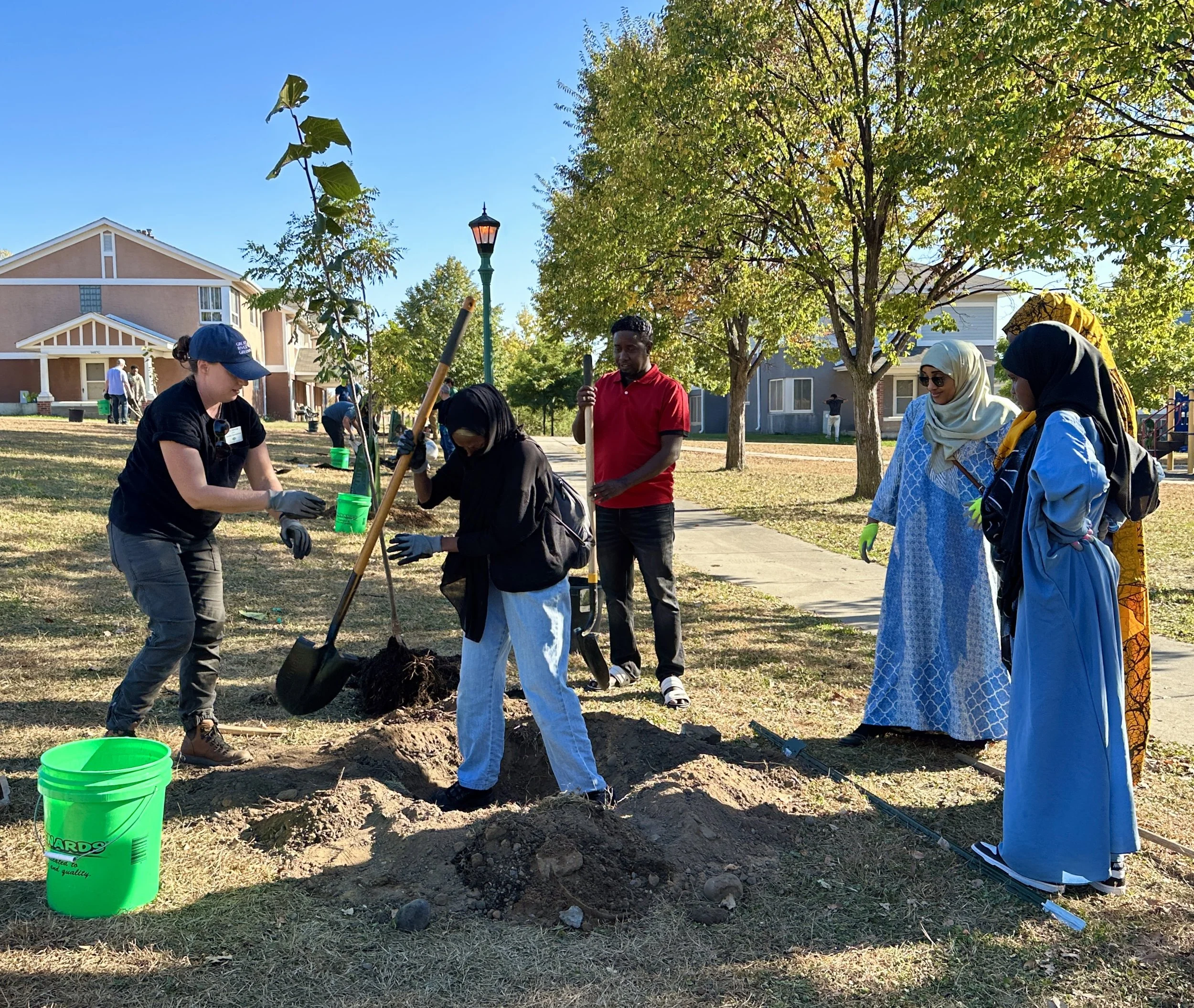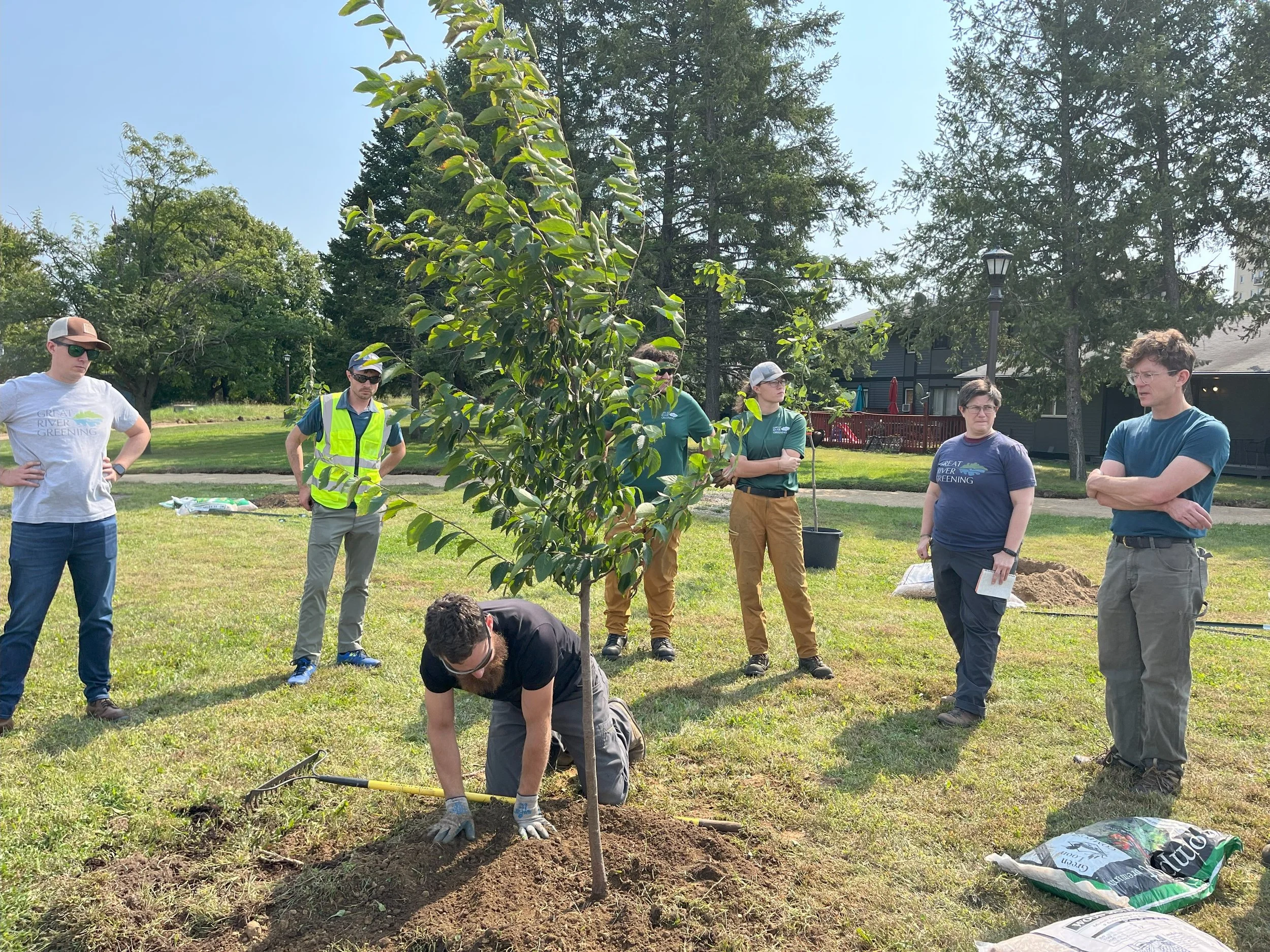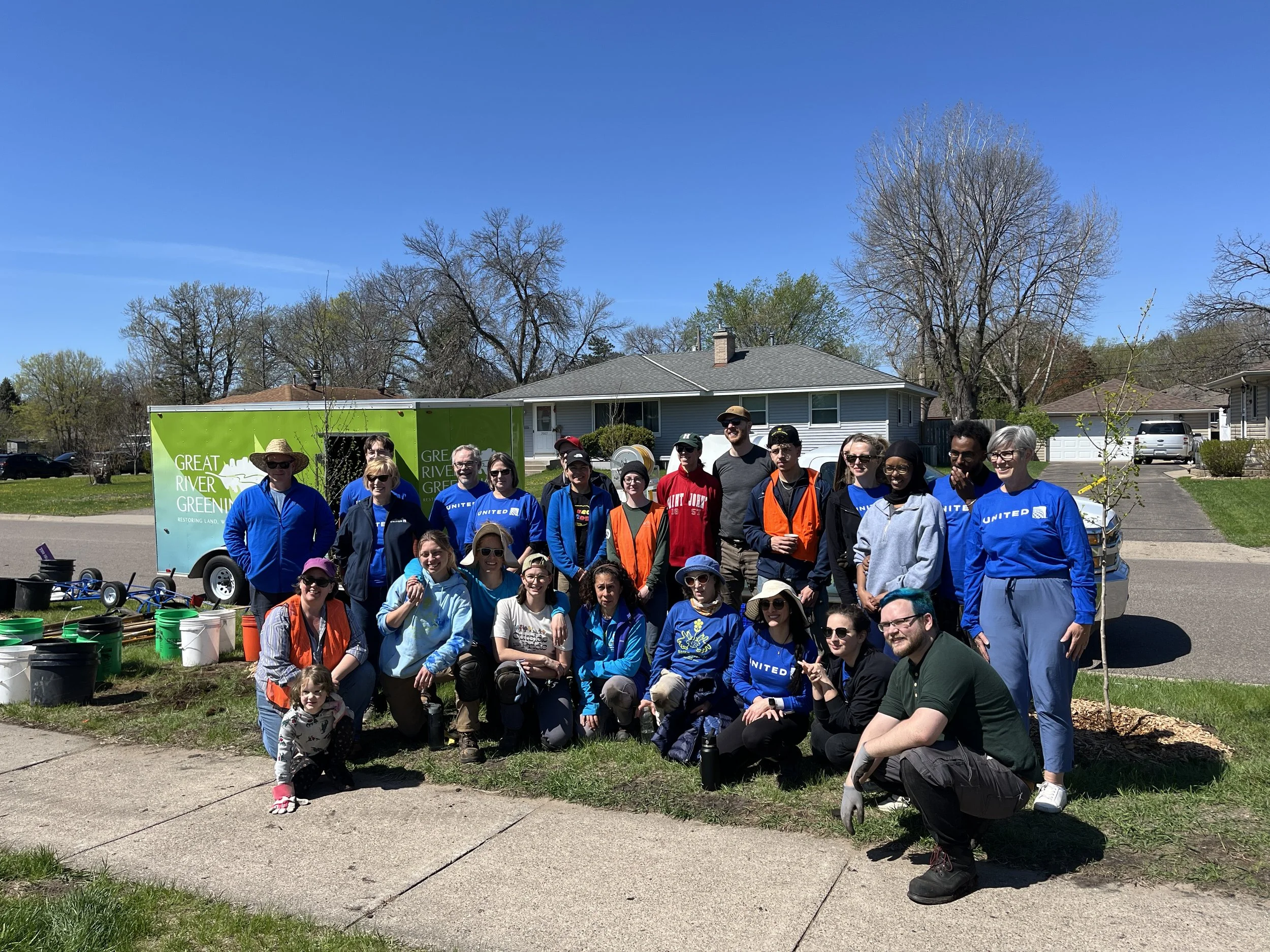Our Cooling Minnesota Communities (CMC) program is a massive tree planting initiative rooted in community-led collaboration, with the goal of planting and watering over 10,000 trees across several Minnesota cities impacted by urban heat island effects.
With this program, we are supporting healthy and resilient urban tree canopies throughout the state of Minnesota. With government and not-for-profit partners in Brooklyn Center, Faribault, Mankato, Owatonna, St. Cloud, and St. Paul, we are planting and watering thousands of trees, giving away free trees to community members, building gravel beds, providing stewardship education about urban heat islands, and more!
Cooling Minnesota Communities is supported by the State of Minnesota and the US Department of Agriculture Urban and Community Forestry Program, making it part of a historically large investment in urban forests nationwide, aimed at improving the spaces where more than 80% of Americans spend their time. Additional project funding provided by the Van Sloun Foundation and the Life Time Foundation.
To see the information about our recent events in Español, Soomaliga, or Hmoob, click here.
Urban and Community Tree Canopy Program
Join your neighbors in getting a free tree from Great River Greening!
As part of our Cooling Minnesota Communities program, Great River Greening will be distributing free trees to eligible residents in Brooklyn Center, Faribault, Owatonna, and St. Paul.
Great River Greening is proud to work with a diverse array of partners to improve urban tree canopies throughout Minnesota:
City of Brooklyn Center
Brooklyn Center Community Schools
City of Faribault
Frogtown Green
City of Mankato
Mississippi Park Connection
City of Owatonna
Osseo Area Schools
City of St. Cloud
St. Paul Public Schools
City of St. Paul
St. Paul Public Housing Agency
Urban Roots
City of Waite Park
Learn More :
-
Trees make city life better!
A healthy urban forest is a critically important nature-based solution to many challenges of city life, delivering benefits like absorbing air pollutants, capturing and diverting stormwater, sequestering carbon dioxide, providing shade and cooling the air, and beautifying communities, to name a few.
Cooling and Cleaning the Air
The CMC program focuses on improving tree canopies in cities because these areas experience a phenomenon called the urban heat island effect.
A city’s sidewalks, roads, buildings, roofs, and other human-made surfaces absorb more solar energy and contain less moisture than natural surfaces.
Daytime temperatures in urban areas can be 1-7 degrees F higher than areas outside cities.
These human-made surfaces also release the absorbed solar energy back into the environment after sunset, meaning temperatures even stay warm overnight, not allowing human bodies to cool down and leading to heat-related illnesses.
Trees function as natural air conditioners, cooling the air around them in two ways.
One, trees’ leaves physically block the sun’s rays from reaching the ground (or people relaxing beneath them!)
Two, the biological process of transpiration, in which water moves through a tree and out of its leaves into the atmosphere, results in cooling the air around trees.
Trees also function as natural air filters, removing dust, nitrous oxide, ozone, and other pollutants that can cause respiratory illness, as well as producing oxygen through photosynthesis.
Other Benefits
Flood Reduction: The hard surfaces found in cities can cause flooding and water pollution during rain events, but the more trees there are in a city, the less severe those impacts will be.
During a storm, tree leaves intercept raindrops as they fall, causing less water to hit the ground during a short period of time, meaning there is less water flowing across hard surfaces that could carry litter or pollutants into nearby waterways.
-
Our focus is on expanding and maintaining tree canopies in areas that need the most— Faribault, Saint Cloud, Owatonna, Brooklyn Center, Mankato, and Saint Paul. New trees will be planted in public spaces—school campuses, city properties, and parks—and free trees will be distributed to area residents.
-
To improve the urban tree canopy in our partner communities, we’re planting thousands of trees each year. We are working closely with our community partners to make sure the trees we plant are not just adding numbers, but are enhancing the overall health and resiliency of the canopy.
Species Biodiversity and Resilience:
In our planting plans, we make sure to include tree species that are native to Minnesota. These native species are well-adapted to our local weather patterns and provide vital habitat and food resources to native wildlife that have evolved alongside these trees.
We also plant species that are not native to Minnesota but are widely used in urban forests because they have proven to be resilient to the many challenges of city life, like droughts or floods, soil compaction, air pollution, and salt. These species have been planted successfully in urban areas in Minnesota and elsewhere without becoming invasive or otherwise harming native plants and animals.
Of course, we are also aware that regional temperature and precipitation patterns are changing, so we are exploring species that are new to our region but have proven to be successful in a variety of climatic and environmental conditions. We integrate these climate-resilient species where feasible in order to future-proof our plantings as much as possible, so these urban forests survive and thrive for decades to come.
And when choosing which species to plant, it is critically important to make sure no tree species, genus, or family is planted in significantly greater numbers than others. Maintaining diversity within the mix of tree types we are planting provides a level of protection for the canopy as a whole. If a new disease or pest affects or kills a particular species and the percentage of that species within the canopy is relatively low, the overall loss of trees in an area will be significantly lower than if that species represented a large minority or even majority of the trees in the canopy.
Right Tree, Right Place:
When choosing which tree species to plant at a location, we work with our community partners to answer a number of questions about the site, including:
The environmental conditions:
How much sunshine does this area receive?
What are the soils like?
Does the area flood frequently
How much road salt would a tree here be exposed to?
The existing tree canopy?
Which other species are present?
Which species have done well? Which are struggling
Are any species overrepresented?
Community priorities for the space?
How do people use this area?
Are there sports fields that should be kept clear of plantings?
Where would shade most benefit the people gathering in or moving through the area?
Where does snow get plowed into piles in the winter?
Taking the time to answer these questions helps to ensure that we are planting the right trees in the right places and giving them the best possible chance of survival.
For more information on tree species selection, check out these great resources from Hennepin County, the Minnesota Department of Natural Resources, and the University of Minnesota!
-
How to Plant a Tree
Whether you’re joining us at a planting event or planting on your own, here are some best practices to keep in mind.
Prepare the tree for planting
If your tree is in a plastic container, you’ll need to take it out before planting. If it’s difficult to remove the container, try carefully laying the tree on its side and pressing on the container while rolling it back and forth. This will help loosen the root ball and separate it from the sides of the container.
Identify the root flare. Look at the trunk of the tree near the soil line and find where the true roots begin to widen, or flare out, from the trunk. You may need to clear away some soil in order to see the flare.
Trim the roots, as needed. If your tree has been growing in a container, it’s very likely the roots have started to grow in a circular pattern. It is critically important to correct this during planting, because encircling roots will likely kill your tree in just a few years. We recommend using a hand saw or serrated knife to slice down each side of the root ball, cutting through the roots so the root ball resembles a box.
Prepare the ground for planting
Request a utility check from Gopher State One Call to identify any underground utilities lines that may conflict with your planting spot. Safety first! (Don’t worry, if you’re attending a Great River Greening planting event, we’ll take care of the utility check.)
Dig an appropriately-sized hole. The hole should be about twice as wide as the root ball and only needs to be deep enough for the root flare to be at about ground level. Don’t dig more than you need to!
Plant the tree
Place the tree in the hole -- leaves up, roots down!
Make sure the root flare will be sitting at approximately ground level. You may need to remove the tree from the hole and backfill soil a few times until you’re sure the tree will be at the correct depth.
Once the tree is at the correct depth, fill the remaining hole space with soil. It can be helpful to step on top of the backfilled soil after every few shovelfuls and add some water to the hole about halfway through backfilling, just to make sure there aren’t any air pockets under the soil that could destabilize the tree later.
Mulch
Applying mulch around the base of your tree is a great way to improve water retention, prevent trees from getting damaged by landscaping equipment, and add a pleasant visual aesthetic. But how you apply mulch matters! Be careful not to pile mulch against the trunk of the tree; this will retain too much moisture on the bark of the tree and can lead to bark rot.
Leave a few inches of space between your mulch pile and the tree; aim to create a mulch donut around the tree, not a volcano.
Water! Water! Water!
Newly planted trees need lots of water while they are establishing roots in their new homes, probably more water than you think. Your new trees should get 15-20 gallons of water per week for the first three years after planting.
Gravel Beds
To support our tree planting efforts, we are also working community partners to construct and stock gravel beds. A gravel bed can be built in a variety of shapes and sizes, but commonly looks a lot like a large sandbox filled with pea-sized gravel. We use gravel beds to temporarily store bare root trees until we are ready to plant them in their permanent locations in parks or along streets.
Spending several months with their root systems buried under gravel allows the bare root trees to develop fibrous root systems, which will benefit them when it is time to be planted.
Gravel beds also make it easier for us to plant using bare root trees, which are less expensive than containerized trees, are easier for volunteers to work with, and are often available in a greater diversity of species.
-
Join us at an upcoming volunteer event and help with hands-on tree and restoration work. Check out our current list of events here!
CMC Projects:
Learn more about how federal funding cuts threaten our Cooling Minnesota Communities program. TAKE ACTION TODAY!










